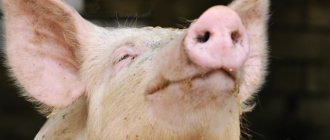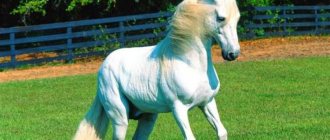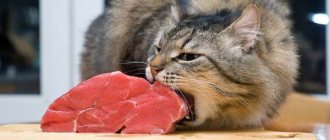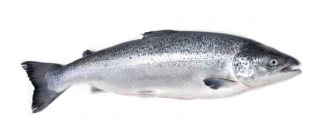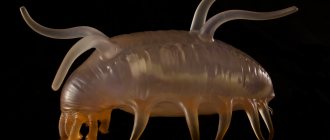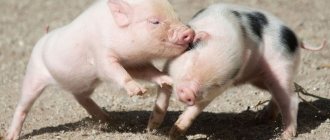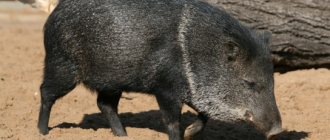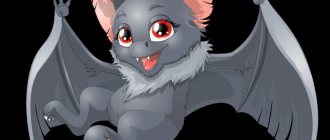Pigs are unique animals; some researchers call them a “biological miracle.” They are 4-5 times more productive than all other inhabitants of the farm in terms of meat production. They have high fertility, but at the same time they require half as much feed as cattle.
Raising pigs is a profitable and profitable business for a home or industrial farm. Today they are grown all over the globe, over 100 different breeds have been bred, differing in constitution, exterior and production characteristics. In the article we will tell you everything about these amazing animals, the main points of pig farming at home.
Description of the pig
Pigs are large animals of the family of non-ruminant artiodactyls, represented by 8 species. They have a powerful and compact build, a long muzzle, at the end of which there is an organ made of cartilaginous tissue for loosening the earth and sense of smell - a snout.
Most breeds have well-defined canines that curve upward. The limbs are four-fingered, the lateral fingers barely touch the surface. Despite their external sluggishness, they are capable of reaching speeds of up to 17 km/h. The hairline depends on the breed, usually sparse and consists of stubble.
Unlike many other farm animals, pigs are omnivores, so it is important to include foods of plant and animal origin when creating a diet. They have 44 teeth, 4 of which are fangs. Weight depends on the breed and can vary from 45 to 400 kg. They have a characteristic small corkscrew tail, large ears and small eyes.
Pigs are highly trainable and are often trained to search for drugs and truffles. Internal organs are used everywhere for transplantation as grafts.
Like many mammals, pigs are good swimmers. In farm conditions, they compensate for this process by wallowing in the mud, which is necessary to cleanse the skin of parasites.
Characteristic
To clarify the full picture, we should delve a little into the history of their ancestors. Wild boars have always been distinguished by their elongated body and sharp heel. Using a nickel, they are able to dig the ground in search of food. Domesticated piglets are not far removed from their ancestors, but some have lost a large number of their special features.
The animal has short legs with finger-like hooves, and the animal's skin is covered with small hair. Sometimes there are bald or very hairy breeds of pigs, which explains their origin and habitat. The color shades are also very different: pink, white, black, brown.
The weight of a domestic pig depends on its length and height; on average, an adult rural boar reaches 140 kilograms, and some even reach 340 kg.
As a rule, the male is much heavier than the sow, even in her pregnant state. Piglets are born weighing 700-900 grams, rarely reaching 1300 grams.
Basic classifications
Over the years of active pig breeding, many breeds have been developed. Several classifications of pig breeds are considered depending on appearance, developmental characteristics and purpose.
According to early maturity
This parameter is especially important for industrial pig rearing. Based on the speed of maturation, the following types are distinguished:
- Late ripening . They have a long head and a straight profile. The chest is flat and the back is narrow, the legs are quite long, and the skin is usually covered with rough stubble. Due to late puberty and a reduced rate of weight gain, the return on investment is poor;
- Early ripening . They have medium body dimensions and a slight profile bend. The body is usually long and wide. The skin is thin and the bristles are soft. By 8 months, pigs of this species gain up to 100 kg of live weight. Sows are extremely fertile and milk producing;
- Moderately early ripening . Usually these are local animals obtained by crossing late-maturing and early-maturing individuals. Used in areas with unstable climate. Have average productivity indicators;
- Very early ripening . They have a small body, weak bones and poor health. Demanding about feeding and maintenance. They grow very quickly.
The choice of breed based on early maturity depends on the climatic conditions in the region, production tasks and maintenance characteristics.
According to the constitution
Depending on the characteristics of the body, the following types of pig constitution are distinguished:
- Rough dense . They have a strong build, coarse stubble, thick ears and angular body features. Usually these are late-ripening and unproductive, but hardy breeds;
- Rough loose . They have thick but soft skin and often have folds on the legs and neck. The bones are weak, thick ears, rough head. Well-developed connective tissue, low resistance to most diseases;
- Tender dense . They have thin but strong bones, the head is light and dry. The ears are usually thin and there are no folds on the body. This body type is often found in domestic breeding early maturing breeds.
- Tender loose . They have thin and weak bones, which causes their back to sag and their legs to bend. The skin is very thin, there is practically no stubble. This type of constitution is typical for very early maturing breeds.
By productivity type
The productivity characteristics of pigs are determined by the constitution of the body, the characteristics of the exterior and development. Depending on these indicators, the following areas are considered:
- Meat . Most common. They have a stretched body, a lightweight front and moderately developed limbs. They are usually well-built animals with an even croup, back and loin. They have an intense metabolism, the slaughter yield is up to 70% of live body weight. Meat breeds include Duroc, meat breeds include Yorkshire, Karmal.
- Bacon . A type of meat pig. They practically do not differ in appearance, but have a greater length of the body in relation to the girth of the chest. As a rule, they have tender meat and a thin layer of subcutaneous fat.
- Greasy . They usually have short and thin legs, a massive and wide body with large developed limbs. They are distinguished by high early maturity and begin to accumulate a sebaceous layer early. They usually have a loose or delicate constitution. Metabolism is fast, fatty pigs are prone to obesity. The slaughter yield is up to 80% of live body weight. The greasy breeds include Landrace and Latvian White.
- Meat-greasy . This is a universal type of pig, they have a relatively long body with rounded and fleshy limbs. The skin is often evenly overgrown with dense bristles. The constitution depends on age, young individuals quickly gain muscle mass, and at older ages the fat content increases.
Features of constitution and exterior are distinctive breed characteristics that can be partially regulated by selection techniques.
Links
- [www.big-fermer.ru/porody-svinei Pig breeds]
- [www.polit.ru/science/2007/09/05/pigs.popup.html Europe was colonized by Middle Eastern pigs]
- Brent Huffman.
[www.ultimateungulate.com/Cetartiodactyla/Suidae.html Family Suidae - Pigs] (English). ultimateungulate.com. Retrieved October 21, 2013. - [animaldiversity.ummz.umich.edu/accounts/Suidae/ Suidae hogs and pigs] (English). Regents of the University of Michigan. Retrieved October 21, 2013.
By age
The most common classification of pigs is the following, which takes into account the age, sex and live weight of the animal.
- Milk pig . A baby pig, regardless of gender, raised under the uterus. The age of suckling piglets does not exceed 2 months. The animal still feeds exclusively on milk, so its meat is especially valued, as it has exceptional tenderness and juiciness, and there is no fat in it. The weight of a suckling pig is from 2 to 6 kg;
- Piglet . This is a young pig aged 2 to 4 months, gender does not yet play an important role. Live body weight from 6 to 20 kg. It is at this age that the transition to traditional nutrition occurs; meat has a high value;
- Gilt . A young female, male or castrated male between 4 and 9 months old. During this time, active growth and development occurs, and puberty begins. In medium breeds, live weight ranges from 20 to 59 kg;
- Adult pig . Starting from 8-9 months, active puberty of the animal occurs, the piglet becomes an adult pig. Depending on the sex, an adult pig is called a sow, boar or hog. Body weight depends on the breed, the norm for medium-sized dogs is from 59 kg.
- Sow . Young females, as well as already farrowed pigs. Only strong and healthy individuals who do not have health problems are selected for breeding. The live body weight of the sow must be at least 100 kg, otherwise problems may occur during pregnancy.
A sow is a farrowed pig.
- Boar (knur) . Uncastrated males capable of reproduction. Sometimes they are called producers. They have good health and large body sizes. Good boars are valued on any farm, so they have a separate diet and daily routine. In large herds, one male can support up to 50 sows per year.
- Hog. An adult castrated male raised exclusively for meat purposes. After castration, the hormonal system changes, so they quickly gain body weight and become less aggressive. Boar meat has a characteristic marbled structure, a delicate taste without a specific smell.
Castration of boars is carried out from the 20th day of life, up to 3 months. After this, the active fattening process begins. Because it is difficult to determine whether a piglet will become a boar, males for production are often selected based on genetic traits, taking into account heredity.
Pig breeding
One of the reasons why pig breeding is so popular is their fertility. In one litter, a sow can give birth to 10-15 piglets; record holders produce up to 20-22. Females go into heat every 18-24 days, the cycle repeats regardless of the season. Pregnancy lasts 110-114 days, the female gives birth easily. Little piglets drink milk for 1-2 months. After weaning, the queen is again ready for mating, so in a year you can get 2 offspring from a pig.
Puberty of the female occurs quickly; at 9-10 months she is considered suitable for mating; boars are capable of fertilization at the age of about a year. When choosing a pair for mating, they look at the boar’s genitals and the number of nipples in the female. They also pay attention to the exterior, how well the pig is recovering.
Mating during estrus occurs without any problems. When a female is in heat, she behaves restlessly, reacts vividly to the male, grunts, the sound of her voice changes, turns to a squeal. Sexual intercourse lasts 15-30 minutes, during which time you should not shout or disturb the couple. In households, double mating is practiced to ensure fertilization and achieve quick results. Sometimes the couple is left together for one or two days so that mating can take place multiple times. On industrial farms, females are artificially inseminated.
Little piglets are born strong and already have teeth in their mouths. After a couple of minutes they know where to crawl to find their mother's udder. A pig has 10 to 16 nipples. During the first feeding, piglets fight for the nipple. The stronger ones grab those that are closer to the female’s head. In the future, the cub comes exclusively to its nipple. Stimulation of the glands by young animals leads to increased milk production. In healthy sows, most of the offspring survive.
Breeds
There are more than 100 breeds of pigs in the world, differing in appearance, production characteristics and early maturity. The following breeds are most often used for home breeding:
- Big white pig . The most common breed around the world. It has high fertility - one sow gives birth to up to 14 piglets, a rapid rate of maturation and adaptation to housing conditions. Adult hogs reach 300 kg, sows – up to 200 kg;
- Landrace: Danish breed of pigs for meat and fat production. They have an elongated body covered with short and soft bristles. They are picky about food and living conditions, but produce valuable meat with a low fat content. The weight of a hog is up to 350 kg, a sow is up to 250 kg;
- Duroc . American breed of meat pigs. They have a unique precocity, rapid weight gain and great fertility. They tolerate unfavorable climatic conditions well. Adult hogs weigh up to 370 kg, females - up to 320 kg;
- Mirgorod breed of pigs . They are distinguished by good adaptive characteristics, unpretentious to feed and growing conditions. They have a strong body constitution and excellent meat characteristics, which are often used for making sausages and canned food. An adult hog weighs up to 300 kg, a sow – up to 230 kg.
The choice of breed is a key aspect of effective pig breeding, since many factors must be taken into account: climate, production tasks, feed and pig barn conditions.
Behavior
Wild pigs began to be domesticated in the Middle East before our era. They were initially kept in a semi-wild state, and it was from Asia that they were brought to Europe. In general, the domestication process took place quite quickly, since this species is characterized by high adaptability and omnivory. Pigs were bred mainly for meat, but skins (for shields), bones (for tools and weapons) and bristles (for brushes) were also used. Pigs were brought to North America from Europe by Spanish pioneers. They often ran away and began to lead a wild lifestyle, causing damage to the economy of the aborigines. Feral domestic pigs in general are a common source of pests, environmental hazards, and damage to agricultural crops. This happens especially often in South America.
Features of Vietnamese
The Vietnamese pot-bellied pig breed is gaining increasing popularity around the world as a farm animal and even a pet. Their wide distribution is due to their early maturation (puberty occurs by 6 months), ease of care and undemanding conditions. They are also distinguished by their unique cleanliness, which simplifies the process of cleaning the pigsty. The Vietnamese pig has strong immunity and good genetic memory.
The meat of this breed of pigs is tender and juicy; in some countries it is served as a delicacy. The volume of subcutaneous fat usually does not exceed the length of two fingers.
According to its description and characteristics, the Vietnamese breed of pigs differs from other herbivorous breeds in its small size and excellent cleanliness.
The Vietnamese breed of pigs became the basis for the decorative Chinese mini-pigs that are popular today.
Notes
- Igor Ivanovich Akimushkin.
The pig is the most precocious and “criminal” animal // Animal World.. - 1st edition. - M.: Young Guard, 1977-1981. - T. 6. - (Eureka). - [www.economist.com/news/christmas-specials/21636507-chinas-insatiable-appetite-pork-symbol-countrys-rise-it-also “Swine in China:Empire of the pig”, The Economist, Dec 20th 2014]
- [anthropogenez.ru/quote/248/ Why pigs are used as organ donors]: based on materials by V. Shumakov, A. Tonevitsky. Xenotransplantation: scientific and ethical issues. Magazine "Man", 1999, No. 6.
- [www.bucknell.edu/msw3/browse.asp?id=14200002 Taxonomy of the Pig family] (English). Mammal Species of the World. Retrieved August 26, 2011. [www.webcitation.org/65Cytzl8P Archived from the original on February 4, 2012].
- Danikov N.I.
[iknigi.net/avtor-nikolay-danikov/46348-ochischenie-ot-parazitov-nikolay-danikov/read/page-1.html Cleansing from parasites].
Pig farming at home
Raising pigs on your own backyard is one of the most profitable types of farming. These animals quickly gain slaughter weight and have high rates of fertility and meat productivity. In addition, pig products are in great demand in the market. In order for pig breeding to be as effective as possible, you must follow all the rules of keeping and care, and also take into account the characteristics of their health.
Content
Pigs are surprisingly unpretentious when it comes to keeping them, but in unfavorable conditions they develop slowly and often get sick. Contents vary depending on weather conditions. For a small livestock, a regular wooden barn is suitable in summer, and in winter it is imperative to equip a heated pigsty. The room should be sufficiently warm, bright and well ventilated.
In a barn, pigs are placed in pens (penes) in groups depending on age, sex and weight. In one pen you can keep up to 30 heads of young animals, up to 10 heads of adults. Sows require a separate room for the entire farrowing period.
Depending on the area of the farm and the characteristics of the breed, free-range, free-range and free-range pigs are used.
Breeding
Puberty in pigs occurs no earlier than 8 months, and farrowing usually occurs 110-115 days after fertilization. Due to such long periods, many farmers try to buy young stock on the market in order to speed up the growing process.
For mating, a pig weighing over 100 kg and without any anatomical or physiological defects is used. Immediately before the fertilization process, she is well fed, increasing the content of vitamins in the food. You can determine a sow's readiness for mating by her behavior - she begins to behave restlessly, redness appears on her body.
Breeding with a boar is carried out within 12 hours after the start of the hunt, and some farms practice artificial insemination.
You can read more about pig breeding in this article.
How to care for piglets
Newborn animals begin to compete and fight for the best place in the sow's udder. During the first days, they distribute the nipples among themselves. Active and persistent piglets outstrip the weak ones and occupy the front teats. At night they sleep quietly next to each other.
When caring for piglets, the following points must be observed:
- In the first days, the baby should be moved to a warm, dry room, and a sleeping place made of straw should be made for him.
- In healthy piglets, the tail is curled towards the top in a ring. If he is lethargic, it means the baby is sick. Pallor and cyanosis also indicate illness.
- The growing process can be divided into several periods: suckling up to a month, growing up to 11 weeks. During the first period, piglets are fed the sow's milk and water. After 2 weeks, you can introduce prestarter food; it contains the necessary nutrients. After a month, the piglets are transferred to a mixture: fishmeal, milk replacer, porridge, boiled potatoes, bread.
- After a month the piglet should weigh 8 kg, and after 2 months 20 kg.
- It is important to observe the conditions for keeping piglets. The room must be clean, dry, ventilated, with well-designed sewerage facilities. Cleaning must be done daily.
Care
Despite popular belief, pigs are clean animals that are sensitive to care. In unfavorable conditions, they often get sick, reproduce poorly and lose weight. When breeding, the following rules should be observed:
- the optimal temperature in the barn for young animals is from 18 to 22 degrees, and for adults – 12-16 degrees;
- the permissible humidity in the pigsty is not higher than 85%, but it is advisable to maintain it at 70%;
- drafts and hypothermia should not be allowed; dampness also has a detrimental effect on health;
- most breeds require regular walks, otherwise pigs develop rickets and their growth rate decreases;
- the water in the drinking bowls needs to be changed every day;
- feeders need to be cleaned daily and washed with an antiseptic solution once a week;
- at least once a month it is necessary to carry out disinfection and disinfestation in the barn; observe the diet and diet;
- veterinary examinations must be regular, at least once every 3 months.
Features of care differ depending on age, number of livestock, as well as the direction of the breed and breeding objectives.
Boar breeding
To provide boars with normal living conditions, it is necessary to buy or build a large enclosure.
In most cases, enclosures are built from durable metal mesh. In this case, its thickness should be 6 mm or more.
The net is stretched over concrete pillars dug into the ground. The section of the structure must fit tightly to the ground. Otherwise, the boar may dig a hole and run away.
A shelter should be built on the territory of the pen, and a small pond should be equipped so that the animals can use it.
To summarize, we note that pig breeding is a very profitable business. However, it is necessary to be able to properly maintain animals and monitor their nutrition.
Diseases
If the basic rules of keeping and care are followed, pigs rarely get sick. Basically, diseases are observed in young animals, old animals and females during the farrowing period. The most common diseases in these animals are diseases of a parasitic nature (helminthiases, scabies, lice or myiases), infectious diseases (leptospirosis, pasteurellosis, circovirus infection), as well as reproductive disorders (extinction of sexual desire, uterine prolapse, mastitis). Pigs often have problems with the digestive and respiratory systems, and older pigs are susceptible to arthritis.
The greatest danger to animals and the entire population as a whole are contagious diseases that lead to death. The most famous of them are classical swine fever, foot and mouth disease and anthrax.
Nutrition
Normally, pigs have good digestion and a powerful gastrointestinal tract. They have the ability to digest almost any food, but during the growing process you must follow the rules and regulations of feeding.
The main type of feed used is a wet mash consisting of products of animal and plant origin. Normally, succulent feed should not exceed 30%.
The diet of pigs should be varied
The diet consists of grain mixtures, fresh herbs, vegetables or root vegetables, and agricultural production. An important condition is the content of all vitamins and beneficial microelements necessary for life, which are often added to feed for pigs. If they are deficient, pigs may eat young animals or greedily eat clay.
Feeding characteristics and diet directly depend on breeding objectives. For meat and lard breeds of pigs, the protein and fat content of food should be increased.
Food, especially of animal origin, must be processed, since these animals are susceptible to helminthiasis.
How long do pigs live?
Probably everyone was wondering how long pigs live at home. Large pigs raised in comfortable conditions can live up to 35 years. In large farm herds they rarely live more than 2 years; slaughter occurs after reaching optimal weight, so the fattening period for most breeds is 1.5-2 years. Life expectancy varies depending on the breed. Small pigs live on average 10-15 years, dwarf breeds - up to 8 years.
Sows live longer because they are exploited to their maximum advantage. One female can have up to 20 farrows during her life, but 5-6 is optimal, after which problems with the reproductive system are possible.
Castrated individuals live slightly longer than ordinary males. This is due to changes in the animal's hormonal system.
Premises and necessary equipment
Before starting a family business, the future owner must soberly assess his own capabilities, based on the financial situation of the family, the presence of people in it capable of caring for animals, the size of the plot, its location, the climatic features of the area, the ability to procure cheap feed and many other factors.
Small household farms usually have 1-2 queens and their offspring intended for fattening. Therefore, it is not at all necessary to build a new, fundamental pigsty. To begin with, an ordinary barn is quite suitable as housing for pigs. It is believed that a sow needs a pen with an area of 6 m2, including a fence for babies of the last farrowing up to 1-1.5 months of age, who are still fed with mother's milk.
Each sow must have a separate room or pen.
The area of pens for fattening piglets is allocated at the rate of at least 2 m2 for each individual. Not every pig farmer keeps his own boar: many simply take a male from time to time, or buy sperm from the nearest large pig farm. However, if you do get a boar, it is much more important to place it away from the sows and thoroughly strengthen the walls of the pen than to allocate a large “living space” for the male.
The walls and ceilings of the pigsty must be well insulated to prevent freezing. Floors are most often poured with concrete, since wooden structures can be chewed by animals. Maintaining a heated barn is not a cheap pleasure, so many pig breeders limit themselves to equipping only pens for nursing females and the youngest piglets with heaters.
It is very important to equip the pigsty with sources of natural and artificial lighting (windows and lamps), and also to carefully seal all the cracks so that the pets do not suffer from drafts. The presence of natural or artificial lighting plays an important role when keeping animals.
The presence of natural or artificial lighting plays an important role when keeping animals.
The flooring arrangement in the pigsty is chosen based on how convenient it will be to clean up pet waste
This is perhaps the most labor-intensive area of work, and its organization will have to be approached with special attention. In this sense, today there are two main systems for keeping pigs - Danish and Canadian:
| Technology | Features and Benefits |
| Danish | The system involves fixing lattice wooden panels on top of a concrete floor made with a slight slope. Such shields can be easily washed with a stream of water, removing manure, which then flows into a specially constructed container. Unfortunately, in an unheated pigsty, such an approach is irrelevant |
| Canadian | In this case, the floor is covered with a thick layer of absorbent material (for example, straw or sawdust). When the top part becomes dirty, clean material is added to it. Over time, the lower layers of the litter begin to overheat. This releases heat, which helps maintain a positive temperature in the room in winter. This method of keeping animals is convenient and does not require too much effort. In the most modern (but more expensive) version, it involves the purchase of special fermented materials, the use of which as bedding allows you to effectively process waste into good fertilizer and maintain the pigsty in proper sanitary condition |
Other equipment for farmers starting to raise pigs at home requires feeders and drinkers. You can make them yourself or purchase ready-made ones.
It is important that the equipment is made of materials that are easy to clean from food residues and wash
According to established standards, the pigsty must be located at a distance of at least 12 meters from residential buildings
The pigsty must be properly placed on the site, taking into account not only the convenience of caring for the animals and the ability to avoid discomfort caused by the unpleasant odor, which is almost always present in such premises. In addition to the interests of the pig farmer himself and his family, there are rules prescribed in the current regulations. Thus, according to SNiP 30-02-97, a pigsty cannot be built closer than 12 m from any residential building and closer than 4 m from the border of the neighboring plot.
conclusions
- Pigs are important farm animals of the non-ruminant artiodactyl family. Represented by 8 species and a wide variety of breeds.
- There are several classifications of pigs depending on age, productivity, and speed of maturation.
- For domestic and industrial rearing, meat, lard and meat-fat pigs are used.
- Pigs are unpretentious in terms of housing and care, and their diet and feeding rules directly affect the rate of weight gain and the health of the animal.
- They have good immunity, but due to non-compliance with maintenance and care requirements, diseases of a parasitic or infectious nature, as well as anatomical defects, can develop.
- The average lifespan of pigs on a farm is 1.5-2 years, but in favorable conditions they can live up to 35 years.
Read how pigs are slaughtered and butchered here.
Nutrition
A newly born piglet feeds on its mother's milk for 1 month, but adult piglets need to be fed differently. There are no special features in food for female wild boars or pigs, because they are quite unpretentious animals.
Approved foods that can be fed to domestic pigs:
- First-class meat products, suitable for adults and piglets during weaning.
- Any vegetables: potatoes, corn, pumpkin, beets - boiled.
- Cereals.
- Peas.
- Bran, buckwheat.
Allowed for preventive purposes: chalk, clay, flour.
Feed preparation
- Grass. Two hours before feeding, chop fresh grass, pour hot water over it, and cover with a lid. Mix the steamed mass with mashed boiled potatoes, add concentrates. To improve the taste, add a little whey or skim milk.
- Concentrated feed. When feeding whole grains, a significant amount of them is not digested. For greater savings, concentrates are given in ground form.
- Potato. It is fed boiled and mashed. Before cooking, the tubers are washed.
- Roots. They are given raw in small quantities as a vitamin supplement. In this case, it is necessary to clean the root vegetables from dirt, cut out rotten areas and chop them. When used as a main feed, they are crushed before cooking and supplied in crushed form.
- Hay. It is crushed using a straw cutter, doused with hot water and steamed for two to three hours.
- Chaff. It is steamed for two hours and fed mixed with boiled potatoes or root vegetables.
- Oat milk. Has good taste. They are used to water the feed for better palatability. A kilogram of oatmeal is poured with boiled water, cooled to 30 degrees, and left warm for 3 - 3.5 hours. Then filter through a sieve.
First, let's decide - why do you need a pig? Are you fattening for yourself or for sale? For the purpose of obtaining meat or lard? If we are fattening piglets for sale, we take a wild boar - it grows faster, has a greater increase in live weight, and is easier to castrate compared to a pig. If we take a pig for ourselves, pig products obtained from a female have a more delicate taste.
Fattening periods
- Lactic. Continues until two months of age. Small piglets are fed five to six times a day, little by little, at the same time. They quickly get used to the established regime. Milk is a very fertile medium for the growth of bacteria that can cause diarrhea in piglets. Therefore, the dishes with milk are left for 15 minutes, then removed and washed thoroughly.
- From the age of one month, carrots, hay dust, boiled and mashed potatoes are introduced into the diet.
- The basic rule is that feed is given as much as the pig can eat at one time; uneaten leftovers should not be mixed with a new portion of food.
- Boars should be castrated at the age of one and a half months.
- Growing up. This is the most crucial period. During rearing, it is necessary to ensure the most complete growth of bones and muscle tissue. It is necessary to make full use of the possibilities of grazing. With such cheap food as young grass, you can increase the weight of a piglet to 50-60 kg in 4 months. 100-110 kg of concentrates per head are required for the entire rearing period. Additionally, kitchen waste is also fed to the pig.
- Fattening When the piglet reaches 40-50 kg, fattening begins, which lasts at least three months. It is not enough to create the right diet and balance it with nutrients, vitamins, macro- and microelements. It is necessary to ensure that the pigs eat the feed with appetite, as this promotes good digestion of the feed and its most complete digestibility.
Preparing for farrowing
A couple of days before the expected farrowing, it is necessary to clean the stall, treat it with a disinfectant, and wash the pig’s udder with warm soapy water. The farrowing area should be warm, bright, dry, without drafts. You can use hay or straw cuttings and dry leaves as bedding. In the corner where the queen has made her nest, planks are nailed to both walls at a height of about 40 cm from the floor. This is necessary so that the pig, when lying down, does not crush the piglets. Typically, the pig begins making her nest approximately 12 hours before farrowing.
